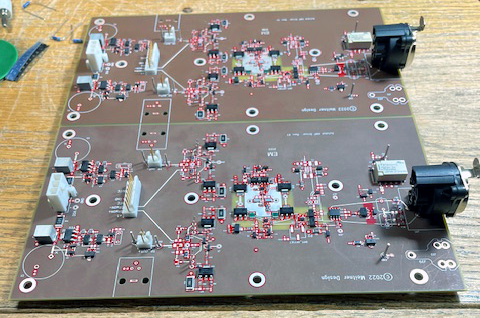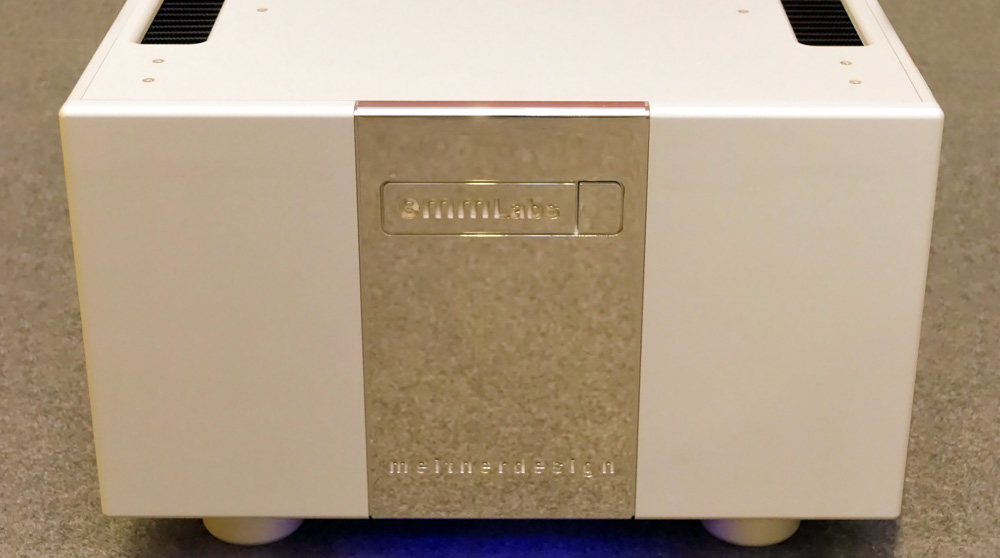Have you ever encountered someone who refuses to leave well enough alone? Almost as soon as my original review of the EMM Labs MTRX amps had been submitted, Ed Meitner began tinkering with the design of the amps’ input boards. In the next five years, three iterations of the boards appeared on my doorstep, courtesy of FedEx. The boards can easily be switched out with no soldering required. In fact, it takes more time to remove the sixteen screws securing each top plate than to change the board. Each new board was an improvement over the last; the third was quite a dramatic improvement, particularly in the bass. For the last year, there have been rumors that new input boards and other changes were imminent as well as similar changes to the smaller MTRX II, which uses the same input boards. Those rumors turned out to be true.
What follows are my initial impressions of the effect the new input boards had on my amps and should be indicative of the direction the new versions of the amps (both the MTRX and the MTRX 2) will take and how they will sound. For those who already own the amps, the factory can provide update details. The change to the MTRX is designated by the factory as the MTRX SE (Special Edition) and is part of the V2 package for the MTRX2 amps.
Listening
(Comments are organized by the piece of music being played.)
Kurt Rosenwinkel, The Remedy (CD)
I hadn’t heard this recording in a while; had overplayed it so much over the last couple of years that I had retired it from my playlist, and enjoyed coming back to it. It is a live recording and is not perfect, being sometimes somewhat congested and dense. Rosenwinkel was drenching his guitar with effects, as well as singing along. The singing was lightly miked. Thus, there was ample opportunity for aural heavy weather. With the updated EMMs, I had no real difficulty following whatever instruments I chose at any moment with surprising clarity and separation. I like Rosenwinkel’s sound almost no matter what he’s doing to it, and I enjoyed the clarity of his density in a way I hadn’t quite heard before. This was particularly true in the first few minutes of Track 4, which was played solo by Rosenwinkel, an unusual stretch of gently moving chordal figures, going rather unexpected places in unexpected ways, most of which were plucked with the fingers. The previous version of the MTRX amps sorted all of this out reasonably well, but I was hearing something new, a level of detail and realism that I had not previously heard.
Weather Report, Tale Spinnin’, Side 2 (vinyl)
From the first cut forward, the soundstage was excellent, very wide, and instrument placement was outstanding. This underlines what an excellent recording this was in the mid-70s — also an excellent pressing by Speakers Corner.
On the second cut, the very active drummer was superbly recorded and reproduced. The kick drum was tight and solid, with excellent presence, but not outsized. Again, the soundstage is uncommonly wide. The speakers effectively disappeared. It is worth noting that with speakers like the Acapella Triolons that are large and rely on multiple drivers, it is not always easy to make them disappear.
Synthesized deep bass by Joe Zawinul had better impact and clarity than I recall ever having heard in both the 1st and 2nd cuts; indeed, I don’t recall hearing it like that before. The bass drum was not only convincingly placed, but it also had the rounded, full body of a drum, not just a disembodied thump. I could feel its impact and yet hear in it the fullness of the instrument that it is. This kind of fullness of soundstage along with spatial detail, including at times a depth of silent ambience, has given me a greater appreciation for this record that came at an odd pre-Jaco juncture for Weather Report. They were creating an electric jazz that was new and enticing, without forgetting their roots.
U2, Joshua Tree
Like many others, I’m very fond of this record. I like it loud. The rhythm is so potent but, with Eno and Lanois in the background, so is the soundscape, which is dense, complex, and almost infinitely interesting. It is also fertile ground for the best systems to penetrate and explore. (That it could still have an attractive effect on, for example, a car stereo, is a puzzle to me, but so be it.)
The EMM upgraded boards were revealing of more of the mystery, in a very satisfying way. The bottom end was terrific: there were some synthesized bass parts in the first and third cuts that I simply had not heard before in such detail and specificity. Indeed, I am hoping I won’t hear from the neighbors about this! The instrument placement and focus, and that of Bono’s voice, was extremely effective, as is the space around the instruments. Yet, the sum total was completely effective, and affecting. In terms of being carried on a journey by recorded music, this is as good as it gets.
Stokowski, Wagner, Acoustic Sounds reissue of an RCA (vinyl)
Like the Weather Report LP, the soundstage was wall-to-wall. The clarity of detail was superb, with no loss of musicality. In other words, it is detail in the service of the music, rather than a simple hi-fi effect. The color of the winds was brought fully to life throughout the range of the instruments, not just at the surface.
The EMM’s did much of this prior to the new boards; however, what I heard here struck me simply as the obvious next level with no change from the fundamental sound and musicality of the earlier iteration of the amps. This was carrying a great design further up the chain.
Electric Recording Company, Strauss, Last Songs, Elizabeth Schwarzkopf
This is an absolutely stunning reissue of what was already, in the original pressing, simply stunning. With the EMM upgrades, the musical experience was further heightened. I do not use the term “liquid” very often in reference to the reproduction of music. It is a vague term, a metaphor that can capture something that is hard to explain, that is difficult to pin down. In listening to this record this evening, what I hear was truly liquid. The music moved forward with an effortless sensuality. I find it somewhat difficult to be concerned about what is working among the individual components. What I do know is that it is for moments like this that I remain deeply involved in the world of hi-fi.
I know too that as I find myself drawn to Schwarzkopf’s gorgeous voice, which seems as if it is fifteen feet in front of me, I did not hear her with quite this specificity prior to the recent updates to my amps.
Strauss, “Der Rosenkavalier Suite” from Strauss Box Set, DGG (Boston Symphony Orchestra, Andris Nelsons)
The imaging was excellent, almost analog — I could almost hear the back of the hall. The instruments were fully fleshed out. There were a number of sections that were chamber-like, and these were lovely in their convincing intimacy. I found it easier than it used to be to forget about the issue of analog versus digital. I believe this is due to the greater detail provided by the upgrades. The bass, when it appears toward the climax in Track 11, was terrifically convincing and solid.
Conclusion
The new input boards represent a step-change in performance, a dramatic improvement. I really liked the previous version 3 boards and was not prepared for the rather substantial improvement I heard from the latest version. The presentation is more spacious with greater air around instruments, transients are more graduated and more realistic, tonal balance is not much changed, perhaps a bit more presence in the mid bass. The highs seem less sharply edged, particularly with digital sources. Note that there is also better resolution of detail throughout the frequency range, but most clearly noticeable at the top. There is no accompanying brightness or edge. Bass is also improved, not so much more bass, but better defined, so that I am noticing things that I had missed or overlooked before. There is also significantly more sub-bass, if in fact the source material contains any.
All-in-all, this is a very worthwhile improvement. Upgrades should be available mid to end summer 2024.
Copy editor: Dan Rubin
- (Page 1 of 1)



